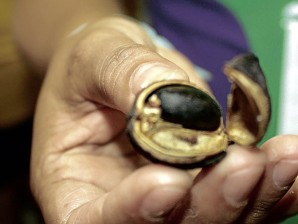‘Tuba-tuba’ poisoning justifies tree cutting

A PARENT shows the inside of a jatropha fruit, which made 30 children ill on Feb. 16 in Barangay San Nicolas 1, Sasmuan, Pampanga. E.I. REYMOND T. OREJAS/INQUIRER CENTRAL LUZON
SASMUAN, Pampanga—Officials of Barangay (village) San Nicolas 1 in this coastal town on Monday felled two Jatropha curcas trees in the village to avoid more incidents of food poisoning.
The council decided to cut the trees, galumbang or tuba-tuba to villagers, after 30 children, aged 3 to 12, fell ill from eating the trees’ fruits last week, village chief Eleno Luna told the Inquirer on Tuesday.
“I am afraid that if we don’t cut those trees, more children would be poisoned,” Luna said.
He said at least nine of the children were taken to Escolastica Romero District Hospital in Lubao, 20 more to Diosdado Macapagal Provincial Hospital (DMPH) and another in Rosario Hospital, both in Guagua, on Saturday night.
Those taken to the DMPH complained of abdominal pain. Several of them suffered from severe dehydration due to vomiting, said Dr. Darwin Cruz, who attended to the children. In all, there were eight girls and 22 boys.
It was the first of such incident in the provincial government-run hospital, Cruz said.
This was the second reported incident in Pampanga. In June 2011, 27 children in Angeles City got ill after eating jatropha fruits that they mistook for small apples.
At DMPH where the children were confined, their parents said an older boy gave a younger boy a nut-looking fruit.
“It tasted like peanuts so I shared some with my playmates,” the younger boy told the Inquirer. When the other children did not get their share, they virtually raided the trees.
The trees are five houses apart and who planted these is unknown. “Probably, [these trees sprouted from undigested seeds in] birds’ droppings,” Luna said.
As tall as 9 to 10 feet, the trees grew along the barangay road, ignored by villagers until the food poisoning incident happened on Saturday.
Nobody opposed the decision to cut the trees. Some old residents, however, regretted losing the trees because the leaves are used to heal dislocated bones.
“I will feel very sad if more children get sick because of those trees,” Luna said.
The Department of Energy (DOE) said the Jatropha curcas is a “nonedible plant that grows mostly in tropical countries like the Philippines.”
“As potential source for biodiesel, the jatropha plant can produce an oil content of 30-58 percent, depending on the quality of the soil where it is planted. Its seeds yield an annual equivalent of 0.75 to 2 tons of biodiesel per hectare,” the DOE said. Tonette Orejas, Inquirer Central Luzon














